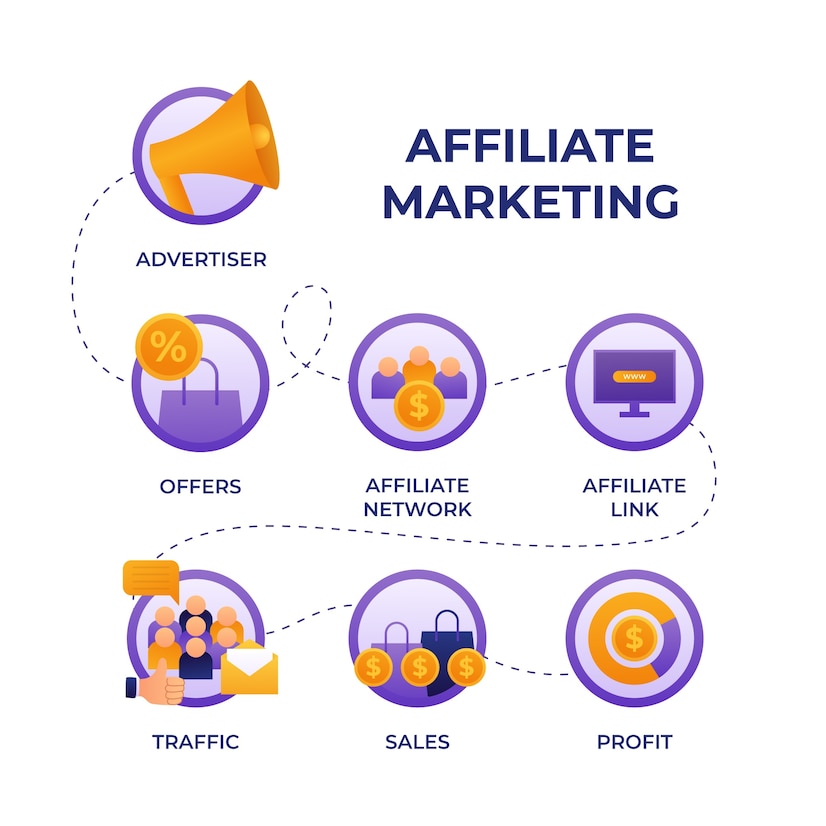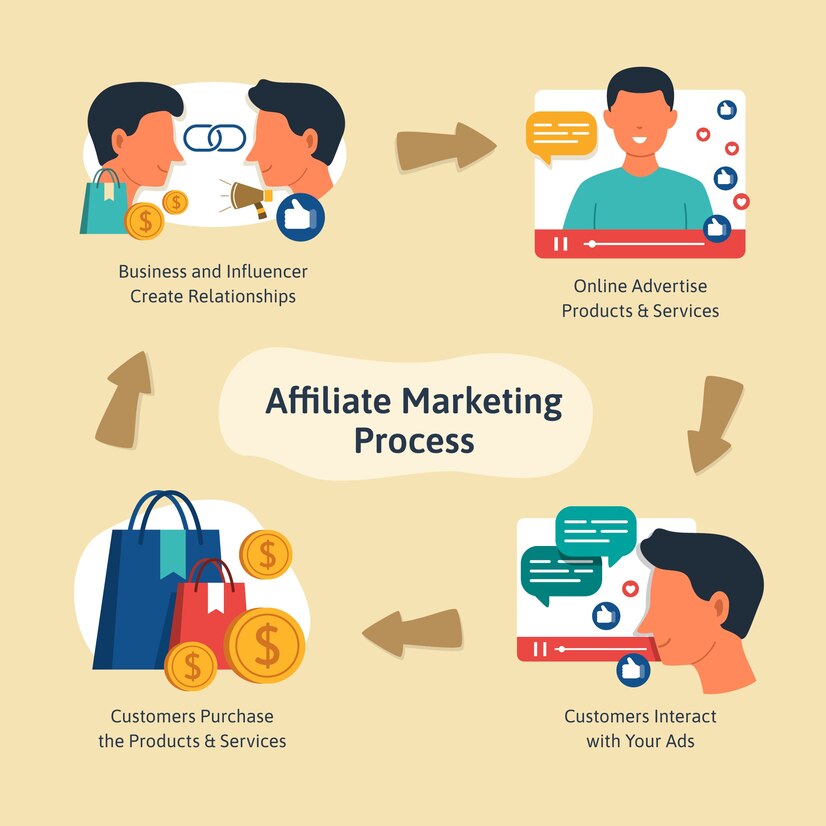How Affiliate Marketing Works?

Introduction
Affiliate marketing is a great way to gain income online, either as an individual or a business, by promoting the products or services of other companies. If you’ve ever wondered how people can just blog and still be solvent, or why some YouTube or social media influencers get paid for basically doing nothing, there’s a fair chance it’s affiliate marketing.
Due to the simplicity and potential profitability involved, affiliate marketing has grown to be one of the most popular means through which people generate income online. But how does it work? In this comprehensive guide, we are going to fully explain the world of affiliate marketing-from what it is down to detailed information on how to get started.
1: Lets Start from Understanding the Basics of How Affiliate Marketing Works?

1: How Affiliate Marketing Works:
Affiliate marketing can be understood, in its simplest form, as a performance-based marketing activity where an affiliate, which can be you, gets paid for promoting a product or service of some other company. Three entities that hold major importance in affiliate marketing are the merchant or advertiser, the affiliate or publisher, and the consumer.
The process of affiliate marketing is straightforward yet effective. Here’s a step-by-step explanation
A: Joining a Program
An affiliate finds an affiliate program he thinks fits his niche or audience and joins it. Upon acceptance, he receives his special affiliate link.
B: Affiliate Promotion of the Product
The particular affiliate decides to promote the product or service through various means of marketing-strategies, though oftentimes, simple blog posts on their blog, or even paid ads are typically sufficient.
C: Consumer Clicks the Link
The moment a consumer clicks on the affiliate unique link, they get transferred to the merchant’s website.
D: Consumer Makes Purchase
Once the consumer buys the product or consummates the desired action, say subscribing to a newsletter, then an affiliate earns a commission.
Key Factors in Affiliate Marketing
A: Merchants/Advertisers
These can be businesses or people making and selling products or services. They join with affiliates to increase their reach and boost sales.
B: Affiliates/Publishers
Affiliates are the individuals or organizations that will be promoting the merchant’s products, usually earning for every sale made upon their promotions.
C: Consumers
The consumers are the direct users who are buying the product or service. They may not be aware of being part of an affiliate marketing transaction.
D: Affiliate Networks
Some affiliate programs are mediated through networks that act as intermediaries between merchants and affiliates. The networks manage tracking, reporting, and payment, and make it easier for affiliates to find programs.
2: Process of Affiliate Marketing

1: Step-by-Step Breakdown
A: Join an Affiliate Program
Pick one that caters to your niche and audience.
B: Get Your Unique Affiliate Link
At this stage, after approval, you will be provided with a unique link, which will track referrals coming from you.
C: Promote the Product
Here, you drive traffic by sharing content through your platform onto the merchant’s website via your link.
D: Earn Commissions
Earn through commissions once Customer makes purchage via your link.
2: Example of a Typical Affiliate Marketing
Now, imagine an affiliate program for a company that sells laptops, where you run a blog about technology. You can write a pros-and-cons review of a laptop and put your affiliate link in it. If one of your readers clicks on that link and buys the laptop, you earn a commission. That’s literally it!
3: Types of How Affiliate Marketing Works?
Affiliate marketing does not have a one-size-fits-all approach; there are various ways you can go about affiliate marketing. Some of them include:
A: Pay-Per-Sale (PPS)
This is the most popular form of affiliate marketing. In this, an affiliate earns a commission each time a sale is made through their link.
B: Pay-Per-Click (PPC)
Under this model, every click that occurs on an affiliate link earns affiliates some money, without anything having to be purchased.
C: Pay-Per-Lead (PPL)
In this case, it applies that affiliates are rewarded through commission when their referral completes an action, such as signing up to a newsletter or filling out a form.
D: Bind-unattached Affiliate Marketing
In this, the affiliate has no relation to the products they are endorsing. They simply place ads or links with much minimal endorsement of the product.
E: Related Affiliate Marketing
This involves the affiliate being related to the product in some sort of way, usually through the niche, but possibly not necessarily using the product themselves. An example of this would be a blogger who travels and talks about their travel but promotes a travel insurance company that they personally don’t use.
F: Involved Affiliate Marketing
This is the most trusted type wherein the affiliate uses the product himself and gives a genuine recommendation to the audience. Through this type of affiliate marketing, strong trust will be built between them and their audience.
4: How to choose the Right Affiliate Marketing Program..?
It is very important that you select an affiliate program that works for you. Here’s what to consider:
1: Things to Consider
A: Relevance
The program you opt for needs to be related to your website content, or at least to the interest of your audience.
B: Commission Rate
The commission rate is the other big thing you want to look into. You would want a niche with competitive commission rates.
C: Cookie Duration
The longer the cookie duration, the better the chances of earning a commission.
D: High-Paying vs. Low-Paying Programs
Some programs give higher commissions but may be hard to sell, while others provide lower commissions and are easier to promote. You have to find a balance.
E: Considering Audience and Product Alignment
Make sure the products which you will be promoting are in line with your audience’s interests and needs. This automatically increases the chance of making a sale.
2: Popular Affiliate Programs
A: Amazon Associates
Amazon would be considered one of the most popular and one of the biggest affiliate programs because of the huge range of products it offers to promote.
B: ClickBank
ClickBank is among the top affiliate programs for digital products, which include eBooks and courses, because it has one of the highest commission rates around.
C: Commission Junction
Commission Junction: CJ also falls under one of the larger affiliate networks that maintain a diverse offering across several industries
5: How to Start Affiliate Marketing..?

1: Finding Your Niche
Finding something that you are passionate about is the first step on this road. Success in affiliate marketing will mean less work when producing content, and you will relate more to your audience.
2: Building a Platform
You will be needing a platform where you can share your affiliate links; this may be in the form of a website, blog, YouTube channel, or even social media presence. The key here is to make sure that the content provided adds value and interests people.
3: Joining an Affiliate Program
When your platform is ready, you can join affiliate programs that best suit your niche. Most programs have some sort of approval process. It is important that your platform appears professional and relevant.
6: Creating Effective Affiliate Marketing Content
1: Writing Product Reviews
Among the most popular options for promoting affiliate products are product reviews. Anytime you go to write a product review, be honest and detailed within the review. Add your affiliate link somewhere in the content.
2: Creating Tutorials and How-Tos
This will add value to your audience, whereby you can naturally place affiliate links into tutorials and how-to guides. For example, if you promote some kind of software product, you could provide a tutorial on how to use such a product.
3: Utilizing Email Marketing
Email marketing helps reach the target audience directly and pitch the affiliate offers in front. An email list can be one of the most potent weapons when it comes to marketing products.
4: Leveraging Social Media
Instagram, Facebook, and Pinterest are some of the great channels for affiliate marketing. Drive traffic by creating creative content with your affiliate links onto these social networking sites.
7: Tracking and Analyzing Affiliate Performance
1: Importance of Analytics in Affiliate Marketing
Most of the work that is involved in doing affiliate marketing has to do with performance tracking. That means it is about being at the top of what works and what does not work.
2: Tools for Tracking Affiliate Links
Certain tools use affiliate link tracking, such as Google Analytics, Pretty Links, and ThirstyAffiliates. This will be very instrumental in helping to track clicks, conversions, and performance overall.
3: Key Metrics to Monitor
- Click-Through Rate (CTR)
- Conversion Rate
- Average Order Value (AOV)
- Return on Investment (ROI)
8: Common Challenges in Affiliate Marketing
1: Competitive Market
The affiliate marketing space is a highly competitive one. To be outstanding, you have to give your audience unique content and build a strong brand.
2: Changing Algorithms
Changes in algorithm constant happen with search engines and social media, which could have a consequence for traffic and ranking. Keep updated and work accordingly.
3: Building Credibility and Trust
Affiliate marketing is all about trust. Only sell what you believe in, and be upfront with your audience regarding your affiliations.
9: Legal and Ethical Considerations
1: Disclosure Requirements
Having said that, let me tell you that disclosing your affiliate relationship with your audience is important. It builds trust and also it is a way to follow legal guidelines.
2: Following the Guides of the FTC
The Federal Trade Commission requires the affiliate to disclose his/her relationship with the merchant. Make sure that it is a clear and conspicuous disclosure on your content.
10: Benefits of Affiliate Marketing
A: Passive Income Potential
With affiliate marketing, passive income potential allows you to make money while sleeping.
B: Flexibility and Freedom
Affiliate marketing opens avenues for people to work at home or set their schedule, which again is one of the major reasons for its attractiveness.
C: Scalability of Earnings
Your earnings are directly proportional to the size of your audience. If you know the right strategies to scale up an affiliate marketing business, then it is a sure way of reaching great heights with much ease.
D: Low Start-Up Costs
Setting up an affiliate marketing business requires little capital investment compared to setting up a traditional business. One does not need to develop a product or incur logistics expenses.
11: Affiliate Marketing Strategies for Success
To be successful in affiliate marketing, it’s critical to leverage appropriate strategies that will help drive engagement with your target audience. This includes but isn’t limited to the following strategies
1: SEO Optimization
Your content is to be optimized for search engines to make sure organic traffic is oriented towards your affiliate links. Keyword research, on-page SEO, and link building are some of the main focus areas.
2: Relationship Development with Merchants
Good relations with the merchants might get you rewards in the form of more benefits on commission rates and other exclusive offers.
3: Keep Learning and Adapting Constantly
The environment for affiliate marketing keeps on changing with every passing moment. To stay ahead of the competition curve, learn and adapt continuously to new changes, trends, and technologies.
4: Content Marketing
this involves the creation of useful and engaging content that seamlessly integrate affiliate links within it.
5: Social Media Marketing
This involves the usage of different social media handles, like Instagram, Facebook, and YouTube, to promote affiliate products to your audience.
6: Email Marketing
Build an email list and create newsletters to send to your subscribers containing affiliate offers.
12: Case Studies: Success Stories in Affiliate Marketing
Example 1: Pat Flynn
Pat Flynn is one of the most popular affiliate marketers who has gained millions through blogging and podcasting on his website Smart Passive Income.
Example 2: Michelle Schroeder-Gardner
Michelle Schroeder-Gardner has a blog called Making Sense of Cents, where she blogs about her path to financial freedom by affiliate marketing of products.
13: The Future of Affiliate Marketing
A: Upcoming Trends
The future of affiliate marketing is bright, and its leading trends include Influencer marketing, mobile optimization, Voice Search, and more.
B: AI and Technology Taking Over
AI and technology have fully invaded affiliate marketing, allowing for easy tracking, optimization, and automation of processes.
14: How to Maximize Your Affiliate Marketing Earnings
1: Promote High-Paying Affiliate Programs
Some affiliate programs do pay higher commissions than others. Target those first, provided they meet your niche. affiliate programs like “Earnkaro, Extrape, Amazon Associate.”
2: Create an Email List
This allows you to send recommendations directly to subscribers who are already engaged.
3: Make Evergreen Content
Make content that lasts a long time, like how-to guides or best-of lists.
4: A/B Test Content
Test different headlines, calls to action, or product placements to find out what works best.
5: Utilize Multiple Platforms
Do not settle for just one platform. Diversify between blogs, YouTube, and social media for an even greater reach.
15: Common Mistakes to Avoid
1: Pushing Too Many Products
You may be tempted to shoot at too many products at once. This simply dilutes your efforts, so try to maintain focus on just a few related products at most.
2: Not disclosing affiliate links
Remember, legally you must disclose the use of affiliate links. This helps to be transparent enough to your readers for their trust in you.
3: Neglecting SEO
No SEO means poor ranking in search engines; hence, traffic becomes minimal.
4: Only Focusing on High Commissions
It’s quite understandable that high commissions are very attractive, but it is also relevant that the product which one is promoting must be genuinely useful to your audience.
Conclusion
Affiliate marketing is dynamic, promising a good source of online income. Knowing the basics, selection of the right affiliate programs, and creating values will successfully drive your affiliate marketing business. Whether you are a complete beginner or an experienced marketer, affiliate marketing always offers areas for growth and adaptation in this ever-changing industry.
FAQs
A: What is the average income of an affiliate marketer?
Incomes could increase or decrease depending on various factors, including niche, experience, and traffic. Some affiliates make only a few hundred dollars a month, and then there are those that receive six or seven figures annually.
2: Is affiliate marketing suitable for beginners?
Yes, affiliate marketing is ideal for beginners since it does have a relatively smooth start-up and very low cost upfront. Plenty of resources will be required from where they could acknowledge and learn to grow.
3: How long does it take to see results in affiliate marketing?
Results with affiliate marketing vary: some marketers may see results in as little as a few months, while others may take up to a year or more before an income stream starts to stabilize consistently.
4: Can affiliate marketing be done without a website?
Of course, affiliate marketing can be done without a website. It’s totally doable on social media, YouTube, or through email marketing.
5: What are the most common mistakes to avoid in affiliate marketing?
Some of the common mistakes include promoting too many products, not being open over the affiliate relationship, avoiding SEO, and lack of trust building with the audience.
6: What is the best niche for affiliate marketing?
The best niche for affiliate marketing is one that you’re passionate about and that has a large, engaged audience. Popular niches include health and wellness, technology, and finance.
7: How much can you earn with affiliate marketing?
Earnings vary widely, depending on your niche, traffic, and marketing strategies. Some cells realize a many hundred bones a month, while others make six- figure inflows.
8: What are the legal considerations in affiliate marketing?
It’s important to disclose your affiliate relationships to your audience to comply with FTC guidelines. This ensures transparency and builds trust with your readers.
9: How do I find the best affiliate programs?
To find the best affiliate programs, research your niche, consider the products your audience is interested in, and evaluate the commission structures and support offered by various programs.



